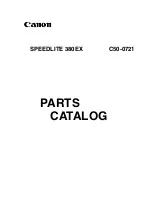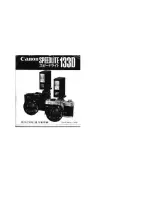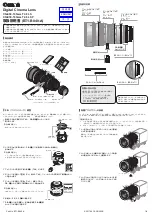
23
En
12. Recommended focusing screens
Various interchangeable focusing screens are available for certain Nikon SLR cameras to suit any
picture-taking situation. The ones recommended for use with this lens are:
◎:
Excellent focusing
○:
Acceptable focusing
Slight vignetting or moiré patterns appear in the viewfinder, but not on the film.
―:
Not available.
( )
:
Indicates degree of exposure compensation needed (Center-Weighted metering only). For F6 cameras,
compensate by selecting “Other screen” in Custom Setting “b6: Screen comp.” and setting the EV level to
-2.0 to +2.0 in 0.5 EV steps. When using screens other than type B or E, “Other screen” must be selected
even when the required compensation value is “0” (no compensation required). For F5 cameras,
compensate using Custom Setting #18 on the camera body. For F4-Series cameras, compensate using
the Exposure Compensation Dial for the focusing screen.
See instruction manual of the camera body for more details.
Blank box means not applicable. Since type M screen can be used for both macrophotography at a 1:1
magnification ratio and for photomicrography, it has different applications than other screens.
•
For F5 cameras, only EC-B, B, E, J, A, L focusing screens are usable in Matrix Metering.
•
When using the B/B2/B3, E/E2/E3 and K/K2/K3 focusing screens in cameras other than those listed above,
refer to the columns for the B, E and K screens.
13. Lens care
• Clean the lens surfaces with a blower brush. To remove dirt and smudges, use a soft, clean cotton
cloth or lens tissue moistened with ethanol (alcohol) or lens cleaner. Wipe in a circular motion
from center to outer edge, taking care not to leave traces or touch other parts of the lens.
• Never use thinner or benzene to clean the lens as this might damage it, result in a fire, or cause
health problems.
• When storing the lens in its lens case, attach both front and rear caps.
• When the lens will not be used for a long time, store it in a cool, dry place to prevent mold. Also
store the lens away from direct sunlight or chemicals such as camphor or naphthalene.
• Do not get water on the lens or drop it in water as this will cause it to rust and malfunction.
• Reinforced plastic is used for certain parts of the lens. To avoid damage, never leave the lens in
an excessively hot place.
○
Screen
Camera
F5+DP-30
◎
◎
―
◎
―
―
―
―
―
―
◎
―
◎
―
◎
―
◎
G1
G2
G3
G4
B
C
E
EC-B
EC-E
F
J
K
L
M
P
U
F4+DP-20
F4+DA-20
F5+DA-30
A
◎
◎
◎
◎
◎
◎
◎
◎
―
―
◎
◎
○
○
(+0.5)
○
(+0.5)
○
◎
○
(−1)
○
(−1)
○ ◎
◎
◎
◎
◎
◎
◎
◎
◎
(−0.5)
◎
(−0.5)
F6
◎ ―
◎
―
― ― ― ◎ ―
― ◎
Summary of Contents for AF-S OX Zoom-Nikkor ED 12-24mm f/4G IF
Page 4: ...4 A B C ...
Page 5: ...5 FULL M A M ON OFF NORMAL ACTIVE AF L MEMORY RECALL AF ON E I F G D H J ...
Page 75: ...Ck 75 ...
Page 85: ...Ch 85 ...
Page 86: ...備註 ...
















































